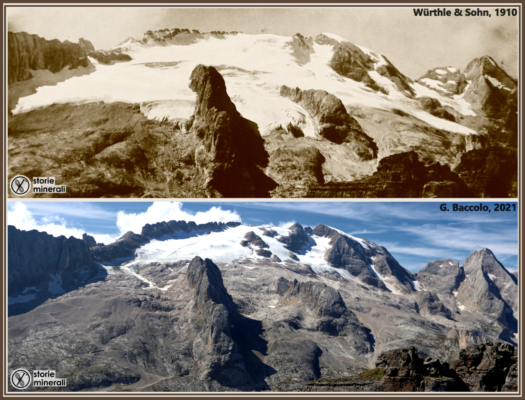
Glaciers are shrinking and disappearing in many regions of the Earth. Did you know? I am joking of course. We are flooded with news talking about this. The decline of glaciers has manifold and severe consequences and is one of the most powerful icons of climate change. Here I want to talk a little bit about one of the less talked about impact of glacier decline: the loss of culture and knowledge related to their disappearance – because with meltwater we are not only losing ice.
Glaciers decline: the perspective of a glaciologist
Look at the 2021 and 1910 pictures above. They are shocking, aren’t them? I am probably biased by the fact that I am a glaciologist and that the study of glaciers and ice is something which I deal with in my everyday life. However, I am pretty sure that most of us would find it difficult to remain unaffected by such views. I admit that looking at these time-lapse photos as a glaciologist, I do not only think of the environmental and socioeconomic impacts of glacier decline, which are definitely severe. I also think, a little bit egoistically, of the fact that the decline of glaciers will inevitably lead to a decline of glaciology as a discipline, and in particular of the branch focused on small mountain-glaciers. Although I don’t live in the mountains, I am used to knowing that if I fancy, I can go visit and study a glacier as a one-day trip. When I see the Alps from my window, and I know that just behind those dark mountain silhouettes there are plenty of beautiful glaciers.
But as a scientist I also know that in a few decades I will probably need two or more days to visit the Alpine glaciers, as the nearest ones, at relatively low elevation, will soon disappear. Most Alpine glaciers, as in many other regions of the Earth, are turning into small and immobile ice bodies, almost completely covered by debris, and surrounded by moraines rapidly eroded by precipitation. To be accurate, they should not even be referred to glaciers anymore, as they lack ice flow and movement, a fundamental characteristic of active glaciers. Glacieret or ice patch is the right term for them (you can find a definition here).
We have been studying mountain glaciers for almost 200 years, and I am pretty sure that in 200 years the number of glaciers on the Earth will be dramatically diminished, with many consequences for the environment and human societies. Through climatic models, we know that it is very likely that many mountain regions of the Earth, the Alps included, will be almost ice-free by the end of the current century. Think about it: it could be the first time that a natural phenomenon as a whole disappears. Glaciological science will not disappear completely, as polar ice sheets will hopefully survive the current climate change for another couple hundred years, but the same cannot be said for its mountain glacier branch.
Glaciological culture: a threatened heritage
Actually, what I really want to talk about is the cultural loss related to glacier retreat. We all know that glaciers are a key element of many mountain landscapes. When you ask children to draw a mountain, they will probably sketch a brown triangle with a white hat, the essential glacier! Well, maybe in 100 years that white cap will disappear, together with our idea that glaciers are a fundamental part of mountain landscapes.
Initiatives dedicated to the commemoration of disappearing glaciers are becoming more and more popular. But then? There’s the risk that once a glacier disappears, we will forget it and the powerful message it sent us by disappearing. This must not happen! I am convinced that as glaciologists we should begin to seriously consider these unconventional sides of our discipline. We need to focus on the cultural role of glaciology, on its history and on its importance for the perception of environmental changes. If we don’t start now to build a glaciological culture, it will be too late and glaciers will be gone like snow in the sun.
This summer I did an experiment to see how widespread the basic knowledge of glaciology and glaciers is. I shared a survey to ask people who know and visit the Dolomites some basic questions about their awareness of the glaciers in this mountain range, among one of the most popular sectors of the Alps. I asked them to list the glaciers they knew about and to explain if they were aware of some basic glaciological terms. For example, I asked if they knew how to distinguish snow fields from glaciers or if they knew that the Dolomites host tens of glaciers that will soon disappear.
The results impressed me! Although hundreds of thousands of tourists visit the Dolomites each year, most of the survey participants were completely unaware that those mountains are home to many small glaciers. They only know the Marmolada glacier (in the opening figure). All the other glaciers in the Dolomites are shrinking in total silence of the high ravines that guard them. Moreover, the people who filled in the form could sometimes not even describe what a glacier is or how to recognize it, even when they stated they usually spend their holidays in the mountains.
We go to the mountains more and more for tourism, but we are already forgetting glaciers. With their disappearance we are also losing the stories about their exploration, investigation and the experiences related to them, an entire cultural heritage that is melting away. We must fight! We must work hard to bring the valuable messages that the glaciers are now sending us to the next generations.
To shed more light on these sides of glaciology, together with some colleagues, Caroline Clason, Ewa Poniecka and Edyta Lokas, we have proposed a session at the EGU General Assembly 2022 which is dedicated to these unconventional aspects of this discipline. If this is something that speaks to you, don’t hesitate to submit to our session, we will be happy to receive your contribution!

A tribute to the extinct glaciers of the Earth and to the glaciologists who studied them. Here are some of them measuring a glacier in the Dolomites (approximately 1930). [Credits: Comitato Glaciologico Italiano]
Edited by Lina Madaj and Marie Cavitte
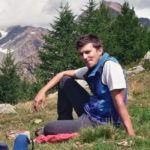 Giovanni Baccolo is a postdoc at the University of Milano-Bicocca, Italy. He studies glaciers to unveil the environmental and climatic pieces of information trapped within ice and snow. His research is mostly focused on ice geochemistry which he uses to study ice cores and supra-glacial processes. He tweets as @g_baccolo, he has a blog (in Italian) dedicated to mountain science and geography (Storie Minerali). Contact Email: giovanni.baccolo@unimib.it
Giovanni Baccolo is a postdoc at the University of Milano-Bicocca, Italy. He studies glaciers to unveil the environmental and climatic pieces of information trapped within ice and snow. His research is mostly focused on ice geochemistry which he uses to study ice cores and supra-glacial processes. He tweets as @g_baccolo, he has a blog (in Italian) dedicated to mountain science and geography (Storie Minerali). Contact Email: giovanni.baccolo@unimib.it

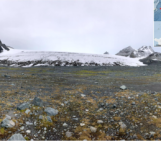
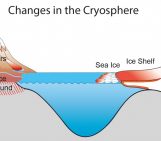

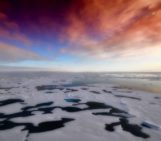
David Crookall
Great post – thank you. The public’s lack of knowledge and awareness on this stuff is frightening. Would love to submit a paper to your session, but (I think that) I do not have enough material to be able to do that. However, please share your work in in climate & ocean literacy https://meetingorganizer.copernicus.org/EGU22/session/43043 or in geoethics https://meetingorganizer.copernicus.org/EGU22/session/43042.
The Mountain Research Initiative may be interested in delivering a paper to your session – contact Caroline Adler and James Thornton.